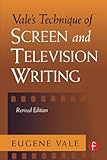Vale's technique of screen and television writing Eugene Vale
Material type: TextPublication details: Boston Focal Press 1998.Edition: Rev. edDescription: xi, 217 p. ill. 24 cmISBN:
TextPublication details: Boston Focal Press 1998.Edition: Rev. edDescription: xi, 217 p. ill. 24 cmISBN: - 0240803558 (alk. paper)
- Technique of screen and television writing
- 808.2/3 21
- PN1996 .V27 1998
| Item type | Current library | Status | Barcode | |
|---|---|---|---|---|
 boek
boek
|
MOBO Non-fictie -1 | Available | 300000325 |
Rev. ed. of: The technique of screen & television writing. c1982.
Includes index.
Introduction: The Exciting New Media -- Pt. I. The Form. 1. The Film and TV Language. 2. The Sources of Information. 3. Enlargement and Composition. 4. The Scene. 5. Selection of Information. 6. Division of Knowledge. 7. Three Types of Storytelling -- Pt. II. The Dramatic Construction. 8. Characterization. 9. Transition of Action. 10. Disturbance and Adjustment. 11. Main Intentions and Subintentions. 12. The Effect upon the Audience. 13. Television, Cable and Pay TV, Video, Satellite Broadcasts -- Pt. III. The Story. 14. From Idea to Final Form. 15. How to Choose Story Material. 16. Understandability, Probability, Identification. 17. Story Content. 18. The Writing of the Script. 19. The Young Filmmakers. 20. The Daring Conviction.
Vale's Technique of Screen and Television Writing, Revised Edition is the author's updated and expanded version of his classic book about the craft and mystery of writing screenplays and teleplays. This revision - of a work acclaimed as one of the best ever written on the subject - provides practical advice for the aspiring and established writer, while distinguishing the unique features of film and television from other forms of dramatic exposition.
Vale's method emphasizes thinking in terms of the camera, defines the realities of filmmaking and traces the evolution of Western storytelling from Aeschylus, through Shakespeare, to the masters of modern cinema. Both philosophical and pragmatic, this is a guidebook for students, professional authors, others who wish to improve their writing skills, and for all film and television enthusiasts interested in knowing more about what they see on the screen.
There are no comments on this title.
